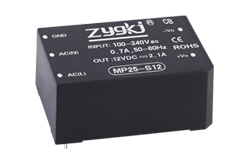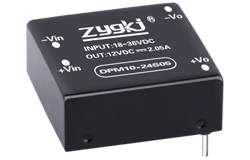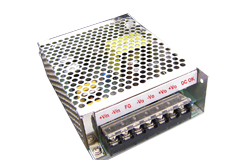خبریں
Building a 120 Volt AC Power Supply for 3 Volts DC
مصنف: زیڈ وائی جی پاور ماڈیول وقت: 2023-4-18
Introduction:
In this article, we will discuss how to build a 120-volt AC power supply for 3 volts DC. This process requires some basic knowledge of electronics and safety measures. We will provide step-by-step instructions to help guide you through the process.
Materials Required:
– Transformer (120V to 12V AC)
– Bridge rectifier
– Capacitor (1000uf, 16V)
– Voltage regulator (LM7803)
– Heat sink
– Wires
– Soldering iron and solder
– Wire stripper
– Pliers
– Safety glasses
Step 1: Safety Precautions
Before starting any electrical project, it is essential to take safety precautions to avoid electrical shocks or fires. Wear safety glasses to protect your eyes from soldering fumes. Ensure that the circuit is unplugged from the power source when assembling or testing.
Step 2: Assembling the Circuit
The first step in building a 120-volt AC power supply for 3 volts DC is assembling the circuit. This process involves connecting the transformer, bridge rectifier, capacitor, voltage regulator, and heat sink. Follow the wiring diagram to connect the components correctly.
Step 3: Wiring the Transformer
The transformer is the first component to connect. It converts 120 volts AC to 12 volts AC, which is then rectified to DC. Cut the wires of the transformer to the required length using a wire cutter. Strip the ends of the wires using a wire stripper to expose the copper strands. Connect the wires to the terminals of the transformer according to the wiring diagram.
Step 4: Wiring the Bridge Rectifier
The bridge rectifier is used to convert AC to DC. Connect the bridge rectifier to the transformer using the wires provided. Ensure that the polarity is correct by following the wiring diagram.
Step 5: Wiring the Capacitor
The capacitor is used to smooth out the DC voltage, reducing any ripples or fluctuations. Connect the capacitor to the bridge rectifier using the wires provided. Ensure that the polarity is correct by following the wiring diagram.
Step 6: Wiring the Voltage Regulator
The voltage regulator is used to regulate the voltage to 3 volts DC. Connect the voltage regulator to the capacitor using the wires provided. Ensure that the polarity is correct by following the wiring diagram.

Step 7: Installing the Heat Sink
The voltage regulator generates heat during operation. Installing a heat sink helps to dissipate the heat away from the regulator, preventing damage. Attach the heat sink to the voltage regulator using screws or thermal glue.
Step 8: Testing the Circuit
Before powering the circuit, it\’s essential to check for any wiring errors or shorts. Use a multimeter to test the circuit\’s continuity and resistance. Once you\’re satisfied, plug in the circuit to a 120-volt AC power source and check the output voltage using a multimeter. The output voltage should be 3 volts DC.
Conclusion:
Building a 120-volt AC power supply for 3 volts DC requires some basic electronics knowledge and safety measures. Follow the wiring diagram and steps provided to assemble the circuit correctly. Test the circuit for any errors or shorts before plugging it into a power source. Once you satisfied, you should have a functioning power supply that produces 3 volts DC.
متعلقہ معلومات
-
2023-10-13
Module Power Supply: Ensuring Reliable and Efficient Electrical Solutions
Introduction: In today's rapidly evolving technological landscape, the demand for reliable and efficient electrical solutions has become more critical than ever. Module power supply plays a crucial role in meeting this demand, offering a wide range of benefits that contribute to the overall performance and longevity of electrical systems. This article explores the significance of module power supply, its functions, and the advantages it brings to various industries. 1. Understanding Module Power Supply: Module power supply refers to the use of modular units to provide electrical power to different devices or systems. These modular units are designed to offer flexibility, scalability, and ease of maintenance, making them an ideal solution in diverse applications. By utilizing modular components, power supplies can...
تفصیلات دیکھیں -
2023-5-2
Industrial AC-DC Converter for Reliable Power Conversion
Introduction An industrial AC-DC converter is an essential component in the power conversion process of various industrial applications such as power supplies and motor drives. The converter is designed to convert alternating current (AC) into direct current (DC) with high reliability and efficiency for the efficient operation of industrial equipment. This article will discuss the importance of industrial AC-DC converters, their design principles, and their key features. Importance of Industrial AC-DC Converters Industrial equipment requires reliable and stable power to operate efficiently. The AC-DC converter plays a crucial role in converting the power supply from the utility grid into the correct voltage and frequency required by the equipment. It is essential to have a reliable converter to ensure the safety...
تفصیلات دیکھیں -
2023-6-28
AC DC Power Supply Module: A Reliable Source of Electrical Power
In today's technological world, electrical power is an essential requirement for almost every electronic device. Whether it's a home appliance, a mobile phone, or a computer, all require a stable and reliable power source. The most common types of power sources are AC (alternating current) and DC (direct current). AC power is used for household appliances, while DC power is used for electronic devices and gadgets. An AC DC power supply module is a device that converts AC power to DC power. The module is a reliable source of electrical power that is widely used in various electronic devices. The module is designed to provide a stable and consistent output of DC power, which is essential for the proper functioning...
تفصیلات دیکھیں -
2023-10-21
Computers have become an integral part of our daily lives. Whether it be for work, entertainment, or communication, we rely heavily on these machines to keep us connected and productive. However, one area that often goes overlooked is the power supply unit (PSU) – the component responsible for supplying power to the various components within the computer. That is why we are thrilled to introduce the revolutionary modular PC power supply, a groundbreaking solution for customized computer power management. Traditionally, power supplies in computers have been designed as a fixed unit, providing a set amount of power to all the components. This one-size-fits-all approach often leads to inefficiencies and wasted energy, as not all components require the same amount of...
تفصیلات دیکھیں -
2023-4-15
An AC-DC converter is an electronic circuit that converts alternating current (AC) to direct current (DC). It is an essential component in many electronic devices, such as power supplies and battery chargers. In this article, we will explore how to build an AC-DC converter. Step 1: Gather Components The first step is to gather all the necessary components. You will need a transformer, a diode bridge, a capacitor, and a voltage regulator. - Transformer: A transformer is used to step down the AC voltage to a lower level. The transformer should have a secondary winding with a voltage rating that matches the desired output voltage of the converter. - Diode Bridge: A diode bridge is used to convert AC to...
تفصیلات دیکھیں -
2023-7-12
The Evolution of Industrial AC-DC Converters: Advancements and Applications
Introduction Industrial AC-DC converters play a crucial role in converting alternating current (AC) power into direct current (DC) power. This conversion is essential for powering a wide range of industrial applications such as motor drives, power supplies, and renewable energy systems. Over the years, these converters have undergone significant advancements to meet the growing demands of the industrial sector. This article aims to explore the evolution of industrial AC-DC converters, highlighting the key advancements and their applications. Advancements in Industrial AC-DC Converters 1. Rectifier Circuits: Rectifier circuits are the fundamental building blocks of AC-DC converters. Initially, passive diode rectifiers were used, which were simple and cost-effective. However, these rectifiers suffered from poor power factor and low efficiency. To overcome these...
تفصیلات دیکھیں

















